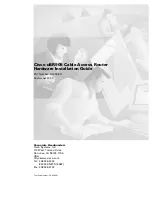
WEA453e Installation Manual
Version 1.0
Samsung Electronics America
Page
50
of
117
No.
Type
Minimum Allowed Bend Radius
Description
3
RG-306D
15 mm
-
* If an allowable cable bend radius is specified by the manufacturer, then comply with that specified bend
radius.
Binding the Cable
Binding the cable means securing and arranging the installed cables using binding thread,
cable ties, binding wire, ram clamps, etc.
Consider the following when binding the cable:
Be careful not to damage the cable while binding it.
Select the appropriate material to use for binding the cables according to the cable's
environment (indoor/outdoor) and usage (power, optical, or feeder line).
When the cut section of the binding material, such as a cable tie or binding wire, is
exposed, it may damage the cable or cause injury. Make sure that these sections are
not exposed.
When using a binding thread, cut 50 mm away from the knot to ensure that it does not
become untied if cut too short.
When a bad connection may occur due to tension in the connector's interlinked area,
bind the cable at the shortest point from the connector.
Connecting the Connector
Connecting to the connector involves assembling a connector to an installed cable and
connecting the connector to a device.
Consider the following when connecting to a connector:
Before assembling the connector, make sure you are fully aware of how to assemble a
connector and proceed with the assembly by matching up the pin map.
There is a hitch on each connector to hold the core position.
Check the groove of the connector and connect it.
The connecting part of the connector on the outdoor feeder line must be wrapped in a
jelly-type heat shrink tube, butyl rubber tape, or insulation tape to prevent water
leakage or rust in the exposed area.
Keep the cables straight where the connectors are linked.
Prevent a bad connection from occurring as a result of tension in the connection area.
















































